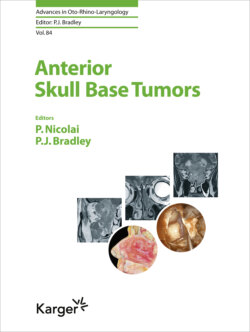Читать книгу Anterior Skull Base Tumors - Группа авторов - Страница 61
На сайте Литреса книга снята с продажи.
Olfactory Neuroblastoma
ОглавлениеThis entity arises from neuroepithelium in the upper aspect of the nasal cavity and roof of the nose and the cribriform plate of the ethmoid sinus. Olfactory neuroblastomas comprise approximately 5% of sinonasal tract malignancies [107–109], and equally affect both genders with bimodal age clustering in the 1st and 2nd and the 4th and 5th decades of life. The tumour presents as a unilateral nasal mass with obstruction and bleeding symptoms [110–112]. Grossly, olfactory neuroblastomas are light tan and soft tissue masses. Histologically, the lesion is composed of small uniform sheets and nests of primitive basal cells with minimal cytoplasm with a neurofibrillary background and occasionally with neuroepithelial pseudo-resetting features (Homer-Wright structure). True rosette formation with duct-like spaces (Flexner-Wintersteiner rosette) are rare. High-grade tumours are characterised by large pleomorphic cells and necrosis [113, 114].
Ancillary markers for diagnosis include keratin, synaptophysin, and other neuroendocrine and muscle markers (Table 2). Amplification of c-Myc oncogene and loss of chromosome 1p have been considered poor prognostic markers.
